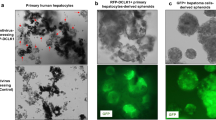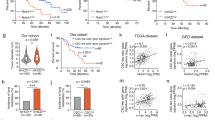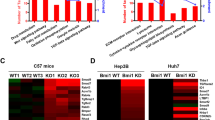Abstract
In human hepatocellular carcinoma (HCC), epithelial to mesenchymal transition (EMT) correlates with aggressiveness of tumors and poor survival. We employed a model of EMT based on immortalized p19ARF null hepatocytes (MIM), which display tumor growth upon expression of oncogenic Ras and undergo EMT through the synergism of Ras and transforming growth factor (TGF)-β. Here, we show that the interleukin-related protein interleukin-like EMT inducer (ILEI), a novel EMT-, tumor- and metastasis-inducing protein, cooperates with oncogenic Ras to cause TGF-β-independent EMT. Ras-transformed MIM hepatocytes overexpressing ILEI showed cytoplasmic E-cadherin, loss of ZO-1 and induction of α-smooth muscle actin as well as platelet-derived growth factor (PDGF)/PDGF-R isoforms. As shown by dominant-negative PDGF-R expression in these cells, ILEI-induced PDGF signaling was required for enhanced cell migration, nuclear accumulation of β-catenin, nuclear pY-Stat3 and accelerated growth of lung metastases. In MIM hepatocytes expressing the Ras mutant V12-C40, ILEI collaborated with PI3K signaling resulting in tumor formation without EMT. Clinically, human HCC samples showed granular or cytoplasmic localization of ILEI correlating with well and poorly differentiated tumors, respectively. In conclusion, these data indicate that ILEI requires cooperation with oncogenic Ras to govern hepatocellular EMT through mechanisms involving PDGF-R/β-catenin and PDGF-R/Stat3 signaling.
This is a preview of subscription content, access via your institution
Access options
Subscribe to this journal
Receive 50 print issues and online access
$259.00 per year
only $5.18 per issue
Buy this article
- Purchase on Springer Link
- Instant access to full article PDF
Prices may be subject to local taxes which are calculated during checkout








Similar content being viewed by others
References
Breuhahn K, Longerich T, Schirmacher P . (2006). Dysregulation of growth factor signaling in human hepatocellular carcinoma. Oncogene 25: 3787–3800.
Bruix J, Boix L, Sala M, Llovet JM . (2004). Focus on hepatocellular carcinoma. Cancer Cell 5: 215–219.
Calvisi DF, Ladu S, Gorden A, Farina M, Conner EA, Lee JS et al. (2006). Ubiquitous activation of Ras and Jak/Stat pathways in human HCC. Gastroenterology 130: 1117–1128.
Campbell JS, Hughes SD, Gilbertson DG, Palmer TE, Holdren MS, Haran AC et al. (2005). Platelet-derived growth factor C induces liver fibrosis, steatosis, and hepatocellular carcinoma. Proc Natl Acad Sci USA 102: 3389–3394.
Campbell JS, Johnson MM, Bauer RL, Hudkins KL, Gilbertson DG, Riehle KJ et al. (2007). Targeting stromal cells for the treatment of platelet-derived growth factor C-induced hepatocellular carcinogenesis. Differentiation 75: 843–852.
Edmondson HA, Steiner PE . (1954). Primary carcinoma of the liver: a study of 100 cases among 48,900 necropsies. Cancer 7: 462–503.
Eger A, Aigner K, Sonderegger S, Dampier B, Oehler S, Schreiber M et al. (2005). DeltaEF1 is a transcriptional repressor of E-cadherin and regulates epithelial plasticity in breast cancer cells. Oncogene 24: 2375–2385.
El-Serag HB, Rudolph KL . (2007). Hepatocellular carcinoma: epidemiology and molecular carcinogenesis. Gastroenterology 132: 2557–2776.
Fischer AN, Fuchs E, Mikula M, Huber H, Beug H, Mikulits W . (2007). PDGF essentially links TGF-beta signaling to nuclear beta-catenin accumulation in hepatocellular carcinoma progression. Oncogene 26: 3395–3405.
Fischer AN, Herrera B, Mikula M, Proell V, Fuchs E, Gotzmann J et al. (2005). Integration of Ras subeffector signaling in TGF-{beta} mediated late stage hepatocarcinogenesis. Carcinogenesis 26: 931–942.
Garcia R, Bowman TL, Niu G, Yu H, Minton S, Muro-Cacho CA et al. (2001). Constitutive activation of Stat3 by the Src and JAK tyrosine kinases participates in growth regulation of human breast carcinoma cells. Oncogene 20: 2499–2513.
Giannelli G, Bergamini C, Fransvea E, Sgarra C, Antonaci S . (2005). Laminin-5 with transforming growth factor-beta1 induces epithelial to mesenchymal transition in hepatocellular carcinoma. Gastroenterology 129: 1375–1383.
Giebel B, Wodarz A . (2006). Tumor suppressors: control of signaling by endocytosis. Curr Biol 16: R91–R92.
Gotzmann J, Fischer AN, Zojer M, Mikula M, Proell V, Huber H et al. (2006). A crucial function of PDGF in TGF-beta-mediated cancer progression of hepatocytes. Oncogene 25: 3170–3185.
Gotzmann J, Huber H, Thallinger C, Wolschek M, Jansen B, Schulte-Hermann R et al. (2002). Hepatocytes convert to a fibroblastoid phenotype through the cooperation of TGF-beta1 and Ha-Ras: steps towards invasiveness. J Cell Sci 115: 1189–1202.
Grunert S, Jechlinger M, Beug H . (2003). Diverse cellular and molecular mechanisms contribute to epithelial plasticity and metastasis. Nat Rev Mol Cell Biol 4: 657–665.
Herath NI, Leggett BA, MacDonald GA . (2006). Review of genetic and epigenetic alterations in hepatocarcinogenesis. J Gastroenterol Hepatol 21: 15–21.
Huber MA, Kraut N, Beug H . (2005). Molecular requirements for epithelial-mesenchymal transition during tumor progression. Curr Opin Cell Biol 17: 548–558.
Hugo H, Ackland ML, Blick T, Lawrence MG, Clements JA, Williams ED et al. (2007). Epithelial–mesenchymal and mesenchymal–epithelial transitions in carcinoma progression. J Cell Physiol 213: 374–383.
Jechlinger M, Sommer A, Moriggl R, Seither P, Kraut N, Capodiecci P et al. (2006). Autocrine PDGFR signaling promotes mammary cancer metastasis. J Clin Invest 116: 1561–1570.
Kensler TW, Qian GS, Chen JG, Groopman JD . (2003). Translational strategies for cancer prevention in liver. Nat Rev Cancer 3: 321–329.
Kondoh N, Wakatsuki T, Hada A, Shuda M, Tanaka K, Arai M et al. (2001). Genetic and epigenetic events in human hepatocarcinogenesis. Int J Oncol 18: 1271–1278.
Lacher MD, Tiirikainen MI, Saunier EF, Christian C, Anders M, Oft M et al. (2006). Transforming growth factor-beta receptor inhibition enhances adenoviral infectability of carcinoma cells via up-regulation of Coxsackie and Adenovirus Receptor in conjunction with reversal of epithelial-mesenchymal transition. Cancer Res 66: 1648–1657.
Lee HC, Kim M, Wands JR . (2006a). Wnt/Frizzled signaling in hepatocellular carcinoma. Front Biosci 11: 1901–1915.
Lee TK, Man K, Poon RT, Lo CM, Yuen AP, Ng IO et al. (2006b). Signal transducers and activators of transcription 5b activation enhances hepatocellular carcinoma aggressiveness through induction of epithelial-mesenchymal transition. Cancer Res 66: 9948–9956.
Macheiner D, Heller G, Kappel S, Bichler C, Stattner S, Ziegler B et al. (2006). NORE1B, a candidate tumor suppressor, is epigenetically silenced in human hepatocellular carcinoma. J Hepatol 45: 81–89.
Mikula M, Fuchs E, Huber H, Beug H, Schulte-Hermann R, Mikulits W . (2004). Immortalized p19ARF null hepatocytes restore liver injury and generate hepatic progenitors after transplantation. Hepatology 39: 628–634.
Ogata H, Chinen T, Yoshida T, Kinjyo I, Takaesu G, Shiraishi H et al. (2006a). Loss of SOCS3 in the liver promotes fibrosis by enhancing STAT3-mediated TGF-beta1 production. Oncogene 25: 2520–2530.
Ogata H, Kobayashi T, Chinen T, Takaki H, Sanada T, Minoda Y et al. (2006b). Deletion of the SOCS3 gene in liver parenchymal cells promotes hepatitis-induced hepatocarcinogenesis. Gastroenterology 131: 179–193.
Pardali K, Moustakas A . (2007). Actions of TGF-beta as tumor suppressor and pro-metastatic factor in human cancer. Biochim Biophys Acta 1775: 21–62.
Pietras K, Sjoblom T, Rubin K, Heldin CH, Ostman A . (2003). PDGF receptors as cancer drug targets. Cancer Cell 3: 439–443.
Rossmanith W, Schulte-Hermann R . (2001). Biology of transforming growth factor beta in hepatocarcinogenesis. Microsc Res Tech 52: 430–436.
Silva CM . (2004). Role of STATs as downstream signal transducers in Src family kinase-mediated tumorigenesis. Oncogene 23: 8017–8023.
Tannapfel A, Busse C, Weinans L, Benicke M, Katalinic A, Geissler F et al. (2001). INK4a-ARF alterations and p53 mutations in hepatocellular carcinomas. Oncogene 20: 7104–7109.
Thiery JP, Sleeman JP . (2006). Complex networks orchestrate epithelial-mesenchymal transitions. Nat Rev Mol Cell Biol 7: 131–142.
Thorgeirsson SS, Grisham JW . (2002). Molecular pathogenesis of human hepatocellular carcinoma. Nat Genet 31: 339–346.
Waerner T, Alacakaptan M, Tamir I, Oberauer R, Gal A, Brabletz T et al. (2006). ILEI: a cytokine essential for EMT, tumor formation, and late events in metastasis in epithelial cells. Cancer Cell 10: 227–239.
Yang J, Mani SA, Donaher JL, Ramaswamy S, Itzykson RA, Come C et al. (2004). Twist, a master regulator of morphogenesis, plays an essential role in tumor metastasis. Cell 117: 927–939.
Yang SF, Wang SN, Wu CF, Yeh YT, Chai CY, Chunag SC et al. (2007). Altered p-STAT3 (tyr705) expression is associated with histological grading and intratumour microvessel density in hepatocellular carcinoma. J Clin Pathol 60: 642–648.
Yoshikawa H, Matsubara K, Qian GS, Jackson P, Groopman JD, Manning JE et al. (2001). SOCS-1, a negative regulator of the JAK/STAT pathway, is silenced by methylation in human hepatocellular carcinoma and shows growth-suppression activity. Nat Genet 28: 29–35.
Zhou L, Rui JA, Wang SB, Chen SG, Qu Q, Chi TY et al. (2007). Outcomes and prognostic factors of cirrhotic patients with hepatocellular carcinoma after radical major hepatectomy. World J Surg 31: 1782–1787.
Acknowledgements
We thank ORIDIS Biomed for providing HCC tissue arrays and immunohistochemical staining. This work was supported by grants from the Austrian Science Fund, FWF, Grant number SFB F28 and P19598-B13.
Author information
Authors and Affiliations
Corresponding author
Additional information
Supplementary Information accompanies the paper on the Oncogene website (http://www.nature.com/onc)
Supplementary information
Rights and permissions
About this article
Cite this article
Lahsnig, C., Mikula, M., Petz, M. et al. ILEI requires oncogenic Ras for the epithelial to mesenchymal transition of hepatocytes and liver carcinoma progression. Oncogene 28, 638–650 (2009). https://doi.org/10.1038/onc.2008.418
Received:
Revised:
Accepted:
Published:
Issue Date:
DOI: https://doi.org/10.1038/onc.2008.418
Keywords
This article is cited by
-
Multiple Mechanisms Explain Genetic Effects at the CPED1-WNT16 Bone Mineral Density Locus
Current Osteoporosis Reports (2023)
-
The FAM3C locus that encodes interleukin-like EMT inducer (ILEI) is frequently co-amplified in MET-amplified cancers and contributes to invasiveness
Journal of Experimental & Clinical Cancer Research (2021)
-
Distinct functions of transforming growth factor-β signaling in c-MYC driven hepatocellular carcinoma initiation and progression
Cell Death & Disease (2021)
-
Ovarian cancer cells direct monocyte differentiation through a non-canonical pathway
BMC Cancer (2020)
-
TGFβ promotes breast cancer stem cell self-renewal through an ILEI/LIFR signaling axis
Oncogene (2019)



